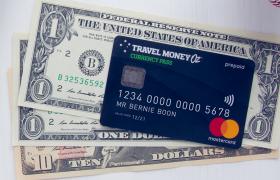As the rule of physics states: what goes up must come down. Unfortunately, such is the case for the Aussie dollar this week which, after a few weeks of upward pressure, has seen its value pulled down as a result of the increasing unemployment rate. It seems the AUD peaked on Wednesday and has since continued on a steady decline. To close out the week, one Aussie Dollar will get you:
0.6607 US dollars
70.1639 Japanese yen
0.5899 Euros
0.5211 Great British pound
0.847 Canadian dollars
1.0395 New Zealand dollars
0.8828 Singapore dollars
If you're planning on exchanging your AUD to foreign currency for an upcoming trip, we recommend adding Rate Move Guarantee to your purchase in-store. It's free, and if the rate improves within 14 days of purchase, we will refund you the difference*.
Increased unemployment rate weighs heavily despite strong employment growth
This week the August jobs report was released, showing the unemployment rate increased by 0.1% to 5.3%. Unemployment is not officially at its worst level in a year.
What's worse is that this increase comes despite strong employment growth. In August 34,700 more Aussies were employed than in July. How can this be the case? Well, the rise in employment is currently being outpaced by the participation rate, or the total number of people working and looking for work. This is further bolstered by strong population growth.
Why does this weigh so heavily on the Aussie Dollar? Our current unemployment rate does not bode well for wage growth, and a lack of wage growth means a lack of extra spending in the economy. An unemployment rate of 5.3% will encourage the Reserve Bank of Australia (RBA) to cut interest rates earlier than expected. Markets now expect the RBA to cut rates by 25 basis points in October instead of November. The earlier rate cut will hopefully encourage a decrease in the unemployment rate to a figure more in line with the RBA's 4.5% goal. Once unemployment hits this figure it is considered 'full employment' and fosters an environment that spurs wage growth and domestic spending that will, in turn, help inflation return to the 2-3% per annum target.
Long story short, no wage growth means people are spending less in the economy, which adds to fears of a recession. Plus, lower interest rates mean investors will move their investments elsewhere seeking a higher return. Fewer investments equate to less demand for the AUD and downward pressure on its value relative to other currencies like the USD.
Domestic news aside, let's see what else has impacted the Aussie dollar this week.
A 50-50 chance of a Brexit deal by October 31
The GBP was boosted slightly this week by the news that European Commission President, Jean-Claude Juncker, said that a Brexit agreement could be reached by October 31. That is providing the Irish backstop was replaced by something that still achieves the same objectives of the backstop. Markets clung to this hope, and the pound experienced upward pressure as a result. It is important to note, though, that Juncker also said he didn't currently see the odds of the deal at more than 50-50.
In other UK news, overnight the Supreme Court ruling into the legality of PM Johnson's decision to suspend parliament concluded. The verdict is expected next week. Should Johnson's decision be deemed legal, the suspension will continue until October 14. However, if it is considered illegal, there will be enormous pressure for Johnson to resign. If he stands down, opposition parties will have the option to appoint a caretaker PM charger with delaying Brexit and calling a general election.
Sigh. For an incredibly dry topic, there really hasn't been a dull moment lately.
Trade Talks between the US and China resume
Trade deputies from the US and China have begun two days of talks. While it is undoubtedly positive that they are talking, White House Economic Advisor Larry Kudlow said there was "little softening" in the mood. Hmph.
Further, President Trump's advisor on China strategy, Michael Pillsbury, said that Trump could quickly increase tariffs and escalate the trade war if he wanted. Thanks captain obvious. It's not like Trump hasn't been doing that for the last year.
Summary: The US and China are chatting, but we have no idea if anything will improve ¯\_(ツ)_/¯
In other US related news, the US Federal Reserve Bank cut interest rates by 0.25% this week. Fed Chair, Jerome Powell, sited the cut (which is the second this year) was a move to stimulate the economy as trade war fears continue to swell. The cut did not have a significant effect on the value of the USD against the Aussie dollar.
Saudi Arabia continues to point the finger at Iran
Following the drone attacks on Saudi Arabian oil facilities last Saturday, both the US and Saudi officials have concluded that the attacks were "unquestionably sponsored by Iran".
Moreover, Saudi officials are also pretty cautious about escalating tensions with Iran and potentially triggering a war. This is especially the case after Iran Foreign Minister, Javad Zarif, warned of the prospect of "all-out war" should the US or its allies launch military action against Iran in response to the oil attacks.
Tensions between Iran and Saudi Arabia are already quite strong, so fingers crossed this can be resolved without an all-out war that could have dire consequences for the world's oil and energy supply.
This blog is provided for information only and does not take into consideration your objectives, financial situation or needs. You should consider whether the information and suggestions contained in any blog entry are appropriate for you, having regard to your own objectives, financial situation and needs. While we take reasonable care in providing the blog, we give no warranties or representations that it is complete or accurate, or is appropriate for you. We are not liable for any loss caused, whether due to negligence or otherwise, arising from the use of, or reliance on, the information and/or suggestions contained in this blog. All rates are quoted from the Travel Money Oz website and are valid as of September 20 2019. Terms and conditions apply to Rate Move Guarantee.















